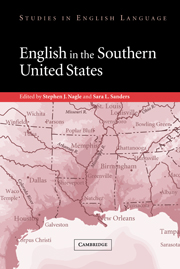Book contents
- Frontmatter
- Contents
- Notes on the contributors
- Acknowledgments
- Introduction
- 1 The origins of Southern American English
- 2 Shakespeare in the coves and hollows? Toward a history of Southern English
- 3 Eight grammatical features of southern United States speech present in early modern London prison narratives
- 4 The shared ancestry of African-American and American-White Southern Englishes: some speculations dictated by history
- 5 The complex grammatical history of African-American and white vernaculars in the South
- 6 Grammatical features of southern speech: yall, might could, and fixin to
- 7 Sounding southern: a look at the phonology of English in the South
- 8 Vowel shifting in the southern states
- 9 Enclave dialect communities in the South
- 10 Urbanization and the evolution of Southern American English
- 11 The Englishes of southern Louisiana
- 12 Features and uses of southern style
- References
- Index
12 - Features and uses of southern style
Published online by Cambridge University Press: 22 September 2009
- Frontmatter
- Contents
- Notes on the contributors
- Acknowledgments
- Introduction
- 1 The origins of Southern American English
- 2 Shakespeare in the coves and hollows? Toward a history of Southern English
- 3 Eight grammatical features of southern United States speech present in early modern London prison narratives
- 4 The shared ancestry of African-American and American-White Southern Englishes: some speculations dictated by history
- 5 The complex grammatical history of African-American and white vernaculars in the South
- 6 Grammatical features of southern speech: yall, might could, and fixin to
- 7 Sounding southern: a look at the phonology of English in the South
- 8 Vowel shifting in the southern states
- 9 Enclave dialect communities in the South
- 10 Urbanization and the evolution of Southern American English
- 11 The Englishes of southern Louisiana
- 12 Features and uses of southern style
- References
- Index
Summary
Introduction
In a local newspaper article covering his retirement as a longstanding member of the school board of Bryan, Texas, Travis Bryan, Jr., a banker and a descendent of the European Americans who founded the city, is described as “defy[ing] stereotypes, vacillating between being a hard-nosed businessman and a God-fearing southern gentleman who is prone to tears when he talks about ‘those little faces looking out of the school bus windows’” (Levey 1991: A1). To the writer of the article, a man like Bryan has to “vacillate” between acting like a businessman and being “God-fearing” and “prone to tears.” Acting like a “southern gentleman” is inconsistent with being “hard-nosed,” and the coexistence of the two ways of acting in one person's repertoire is evidence that he is special.
Bryan “defies stereotypes,” however, only in a fairly stereotypical way. The article's characterization exemplifies an image of what it takes to be a successful Southerner that is frequently adduced in popular discourse about southernness. According to this familiar trope, a person cannot be simultaneously “hard” in the way required for practical efficacy and “soft” in the southern way, so one has to alternate between the two styles. The ideal Southerner is someone who can make effective use of both, someone who can be “hard” (like a Northerner) for strategic reasons but whose more natural style is the “soft” southern one.
- Type
- Chapter
- Information
- English in the Southern United States , pp. 189 - 207Publisher: Cambridge University PressPrint publication year: 2003
- 3
- Cited by



